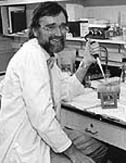| Home | |
| Faculty | |
| Graduate Program | |
| Events and Seminars | |
| Resources | |
| Contact Us | |
|
F A C U L T Y P R O F I L E
Current Research The main goal of our research is to understand the function of the glycosylphosphatidylinositol (GPI) anchor which has been identified on a diverse group of membrane proteins in all major groups of eukaryotes from yeast to man. Although the GPI anchor plays an important role in attaching numerous (>200 identified so far) proteins to the cell surface the sheer complexity of its structure and biosynthetic pathway suggests that it has other, unique and essential functions not provided by more conventional membrane anchors. Various additional functions for the GPI anchor have been proposed in the last few years: e.g. novel cellular signaling mechanisms, intercellular transfer of proteins, localization to particular regions of the cell surface and regulation of expression at the cell surface. However the full range of functions exerted by GPI molecules remains to be determined. The current focus of our research is in two main areas. In one project we are studying the biosynthesis and functional consequences of a common structural modification to the GPI anchor - inositol acylation. We are isolating somatic cell mutants deficient in the expression of the inositol-acylating and -deacylating enzymes with the eventual goal of isolating the genes encoding these enzymes. Mutant cells with altered inositol acylation capabilities will be studied for functional changes. The other project seeks to understand the regulation of an enzyme (GPI-specific phospholipase D) which is relatively abundant in mammalian plasma, but of unknown function. We believe this enzyme releases GPI-anchored proteins from cell membranes and thereby provides a novel mechanism for regulation of protein expression and function at the cell surface. We are currently the dissecting the structure/function of GPI-specific phospholipase D using site-directed mutagenesis and by inhibiting its expression using anti-sense techniques.
Selected Publications Low, M.G., and Brodbeck, U. 1998. Enzymes cleaving the phosphodiester bond in the GPI anchor in Glycosylphosphatidylinositol-anchored biomolecules, S. Ilangumaran and D.C. Hoessli (eds) R.G. Landes Company, Austin, Texas. Xie, M., and Low, M.G. 1995. Streptolysin-O induces release of GPI-anchored alkaline phosphatase from ROS cells by vesiculation independent of phospholipase action. Biochem. J. 305:529-537. Xie, M., Low, M.G. 1994. Expression and secretion of glycosylphosphatidylinositol-specific phospholipase D by myeloid cell lines. Biochem. J. 297:547-554. Wong, Y.W., Low, M.G. 1994. Biosynthesis of glycosylphosphatidylinositol-anchored human placental alkaline phosphatase: Evidence for a phospholipase C-sensitive precursor and its post-attachment conversion into a phospholipase C-resistant form. Biochem. J. 301:205-209. Li, J.Y., Hollfelder, K., Huang, K.S., and Low, M.G. 1994. Structural features of GPI-specific phospholipase D revealed by proteolytic fragmentation and Ca2+-binding studies. J. Biol. Chem. 269:28963-28971 |

